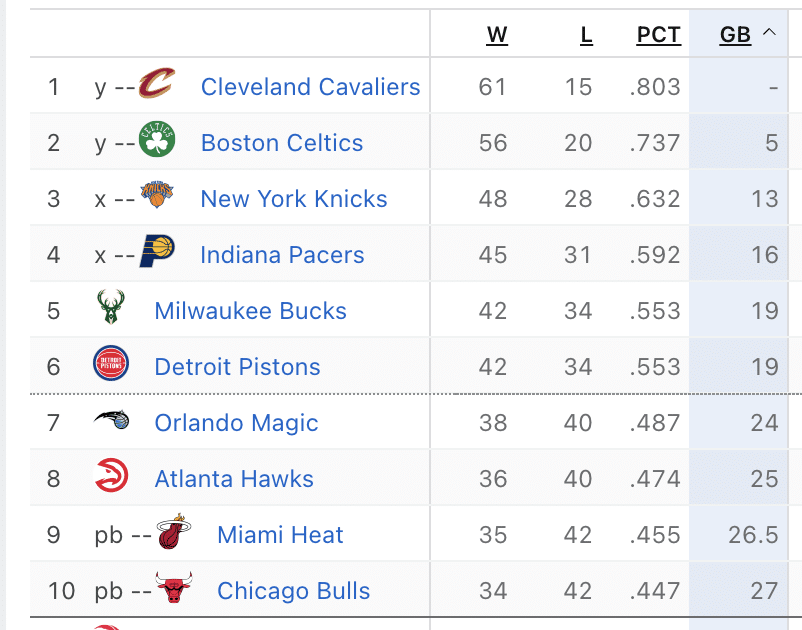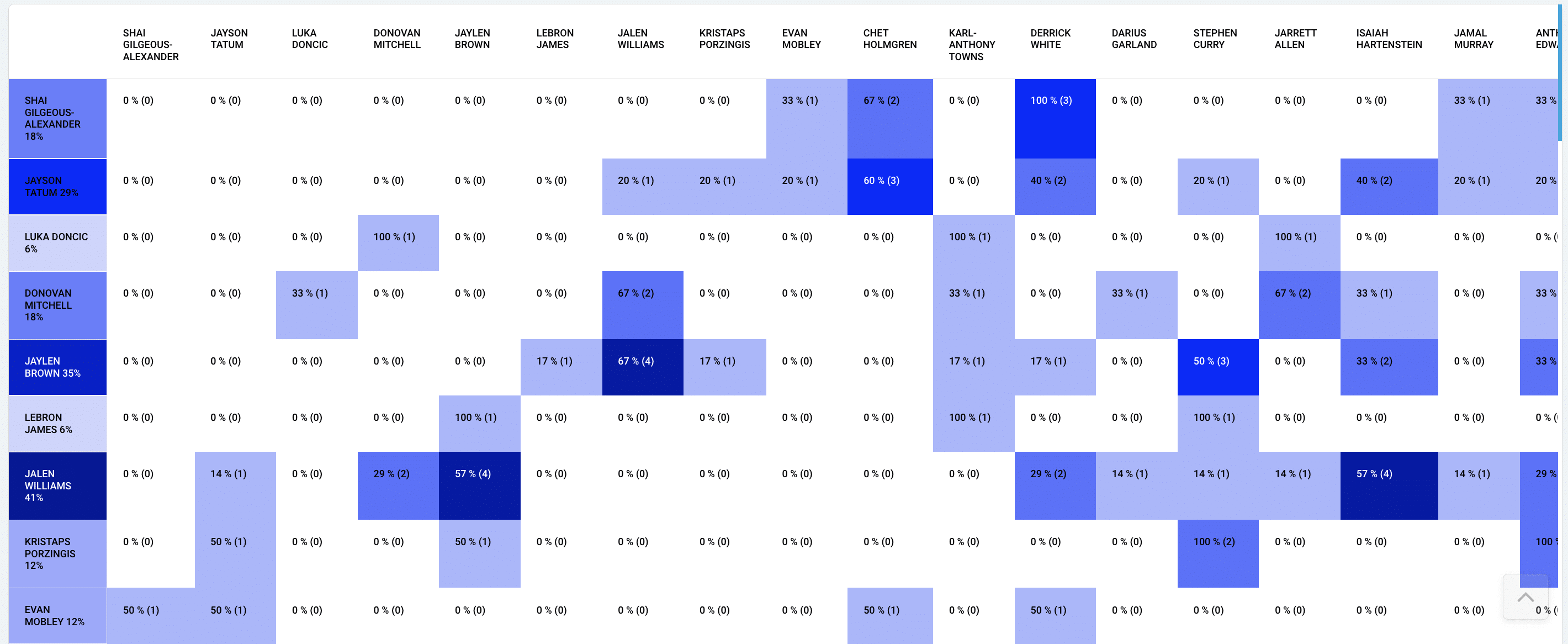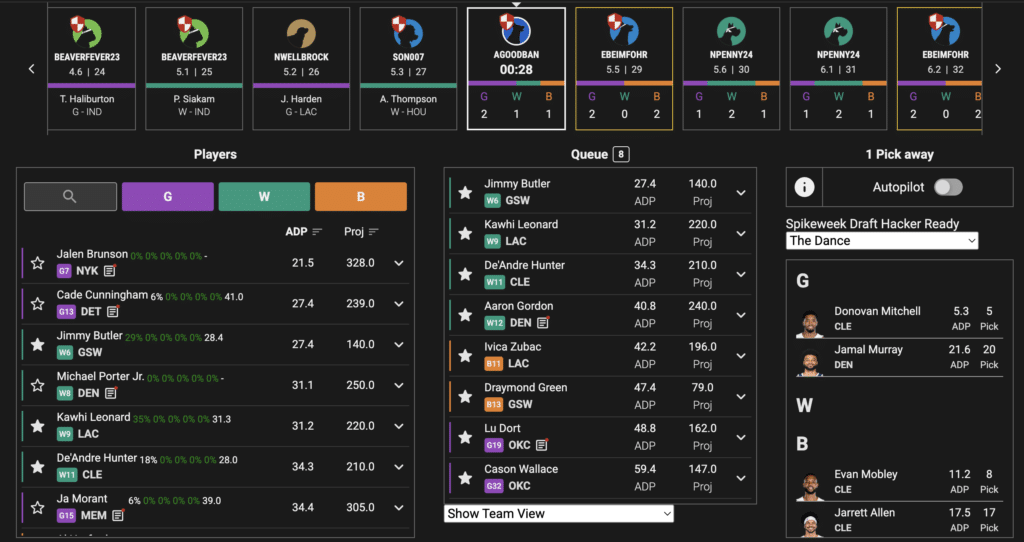NBA Playoff Best Ball on Underdog is arguably the trickiest and most unique Best Ball format that exists, but that also might just make it the most fun. For an overview into the format of these tournaments on Underdog Fantasy, you can check out this guide I have broken down on How to Play NBA Playoff Best Ball on Underdog. This will give you all the rules such as scoring, rosters, rounds & advancements and some general strategy thoughts.
But each year presents new challenges with both the player pool and the actual NBA teams and playoff bracket. Last year was about as successful of a year in terms of prognostication here with the NBA Playoffs as we can hope to have. We nailed the entire playoff bracket, including the Mavs making the finals against the Celtics, other than having the Knicks beating the Pacers to make the Eastern Conference Finals. You can see my full bracket from last season here.
I also broke down each NBA Playoff team as well, and I will be doing so again once the bracket is finalized.
Today, we are going to dive into some overall strategy for the 2025 contests on Underdog.
Underdog Fantasy NBA Playoff Best Ball Strategy (2025)
As I mentioned above, every season in the NBA is extremely unique, which leads to extreme variance year to year in how we need to approach our drafts and what is the best way to attempt to take down these contests. We cannot simply copy-paste what worked last year or in previous years.
2025 brings arguably the most wide open year I can remember in recent NBA Playoff history. The Western Conference was fairly wide open, as you can see in my break down of each team linked above, but this year is taking that to an even higher level.
But let’s start with the simpler conference – The East.
Eastern Conference Breakdown
Last season, while I loved the Knicks and Pacers to make a run or win a couple of series, there was one team that felt pretty inevitable in making the finals, and that was the Boston Celtics. This season, the Celtics are still an outstanding team, but an actual competitor has emerged – the Cleveland Cavaliers. In fact, the Cavs actually have a 5 game lead on the Celtics in the East, running away with the number one overall seed.

I still believe the Celtics are the favorite to make it out of the East, despite those standings, as they’ve cruised a bit more through this regular season resting some players more frequently. Kristaps Porzingis has only played 39 games. However, the Cavs are a real contender this season. Evan Mobley has taken a very real leap that was necessary for this team to compete with Boston, and Darius Garland is back to his high level play after a near wasted season last year where he never fully recovered from the aftermath of his broken jaw and the weight/strength loss. The Cavs also made a sneaky big trade in acquiring De’Andre Hunter to fill a void on the wing that is wildly important both overall and against this Celtics squad.
The Cavs and Celtics split their season series 2-2, and the Cavs will have the home court advantage in their series, assuming neither team slips up along the way. Last year, basically every team I built was with the assumption that the Celtics would make the finals. Obviously you can’t truly have 100% of teams stacking the Celtics, but that was the overall plan, using the Knicks and Pacers to help push the Celtics through each round. But with that home court and their very real improvements, the Cavs have emerged as a second team in the East that I think is truly live to make the finals, and I will be building both Celtics and Cavs teams for the finals in 2025.
I will break down the rest of the East in more detail in the team-by-team breakdown coming at the end of the regular season, but there are really no other true finals contenders across the rest of the East. The Knicks and Pacers are absolutely dangerous, and they will be my picks to square off with the Cavs and Celtics in the second round. But the Knicks defensive flaws with a point guard/center pairing of Brunson and KAT, and the Pacers defensive issues paired with minor offensive issues against elite playoff defenses like Boston and Cleveland leave these teams just a tad short on the necessary strength to upset the big two.
The rest of the East is borderline un-draftable in these contests. The Pistons make for slightly appealing advance rate plays, particularly Cade Cunningham, but that’s about it. The Bucks are the team that I heard on shows and in comments last season that I was wrong about. I picked them to lose to the Pacers and essentially called them undraftable then as well. With Giannis and the notable names, that’s understandable, but this team is simply too inherently flawed to make a real run. They made a desperate trade (that was also about future cap flexibility) shipping Middleton out for Kyle Kuzma, and Bobby Portis will only just be getting back from suspension for the playoffs. Brook Lopez has fallen off the proverbial age cliff, and then it was sadly revealed that Damian Lillard is dealing with a blood clot. Current reports are that the Bucks have “much more hope”, but even if he does return, it is almost impossible for him to be at his peak. He will have missed 15 or so games in a row leading into the playoffs, and this team is simply DOA against good teams without a fully healthy Dame, no matter how good Giannis is.
Western Conference
While the East is pretty straightforward (apologies to the Knicks, Pacers, Bucks and Pistons fans), the West could not possibly be more different. First, let’s take a look at the current standings as of this writing:

I won’t get into breakdowns on each individual team, as I will do that in the upcoming team-by-team breakdown (see last year’s here), but we should note that at a high level there are several teams who can absolutely make the finals here. If we assume whichever two teams of the Mavs, Kings, Suns and Blazers make the play-in both lose, we might have the strongest group of teams 1-8 of all time.
On one hand, that makes things much more difficult. On the other hand, it might actually make it a bit easier in drafts. Even the teams currently sitting in the play-in games at 7th and 8th, the Timberwovles and Clippers, are truly viable finals candidates. And one of them (or a different team who could fall to the play-in) is going to draw a pretty vulnerable Rockets team who is sitting pretty comfortable as the 2 seed.
The Rockets are an excellent story and have had a great season, but they reek of the young, strong regular season team who is still probably a year or two (and maybe a player or two) away from a true playoff run. We even saw this with the Thunder last year. Phenomenal team and regular season performance, but they ran into a peaking, veteran team led by Luka Doncic and Kyrie Irving who made huge additions at the deadline.
Memphis seems to be the other notable team fading down the stretch. I mean, it seems like a pretty ominous sign that they just fired their coach right before the playoffs. On the flip side, any of the Nuggets, Warriors, Lakers, Clippers and T’Wolves seem to be able to beat any of the other on any given night.
I do think it’s necessary to note that I would call the Thunder the definitive number one team here in the West. They will be my pick to come out of the West when I post my bracket here on Spike Week. They’ve made huge strides both in player development and in adding to the roster since last season. They’re having one of the single most dominant regular seasons of all time, despite key players missing time with injury, and some of those issues they had last year have at a minimum been upgraded, if not resolved.
Positional Nuances
One thing that can easily get overlooked in playoff best ball amidst all the focus on teams and stacking is the nuance of how each position (guard, wing and big on Underdog) breaks out both across the entire player pool but also on each team.
You will see this accounted for in our rankings, but it’s also important to understand heading into your drafts.
For 2025, you’ll notice that the wing position is both the weakest and the trickiest. If you want a Celtics wing, you essentially have to draft Tatum or Brown, both of whom are drafted in the first 6 picks. The Cavs barely have a wing, with just De’Andre Hunter and Max Strus in the mid to late rounds. The Thunder have just Aaron Wiggins (who is much more expensive than one would think because of this wing issue) beyond Jalen Williams, who is drafted at an ADP of just over 8. Mapping out your wing position for the teams you are drafting is one of the most important aspects of these drafts.
In an ideal world, we want to avoid as many one offs as possible. This allows us to give ourselves the opportunity of having as many available players as we can in the later rounds (2nd round, conference finals) to navigate through those very difficult advancements with a lot of player overlap on teams. It also takes advantage of the most critical, yet most unpredictable, piece of NBA Playoff Best Ball – games played. We don’t know how many games each of these series will go, but obviously players who play more games are going to score more points. Instead of tossing one off players from a bunch of different teams around our finals matchup, we can correlate as much as possible, and take advantage of when those teams play more games.
Those details are particularly relevant to the positional nuances because we know that wing is weak and difficult to fill for some matchups. The Guard and Big position are quite strong across the player pool, but again certain matchups do run into issues. If you want a Celtics/Thunder finals matchup, you need an early wing, but you also need to understand there are only 4 bigs available on those two teams, two of which are very expensive with the other two in the mid-ish rounds. These kind of situations are vitally important to know when mapping out your team and player pairings.
Rankings
If you are a Spike Week Premium subscriber, you can view and download our NBA Playoff Best Ball Rankings here. The rankings reflect all of the strategy and texture outlined in this piece, and you also get access to all of our Best Ball Tools (like the Draft Hacker and DraftIQ), Rankings & Strategy for every Best Ball sport and more for one low price of $39.99 per month (or $299.99 per year).
Player and Team Combinations
A critical, but very underrated, aspect of these Playoff Best Ball tournaments is how we combine the players we draft, and the real life NBA teams that we draft. We want to build our portfolio of teams in a way that optimizes these team prediction edges that we’ve outlined above and ideally gives us the right amount of combinations of different finals matchups and different players from within those finals matchups.
If you are a Spike Week subscriber, I mentioned that you get access to our Draft Hacker and DraftIQ tools. Once you’ve drafted some teams, you can view these exact combinatorial details within DraftIQ, our exposure analysis tool. Through some of my early drafts, here’s an example in DraftIQ from the Player Combos and Playoff Combos tabs:


During your drafts, you can also use the Draft Hacker, our Draft Overlay tool, to view your player exposure and player combinations live in real-time while you draft, directly on your draft screen. You can customize the options that show on your screen during your draft, and this will allow you to see those player combinations or finals matchups that you may want to make sure you have covered or at the exposure level you’re targeting.

Remember that you can check out this detailed strategy guide for NBA Playoff Best Ball for more details about the game format, and you can also join our Spike Week Discord and hop in the conversation with other super sharp NBA Playoff Best Ball drafters out there talking strategy every day.





